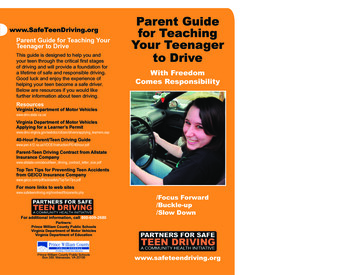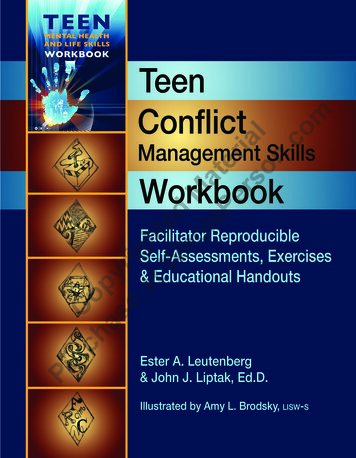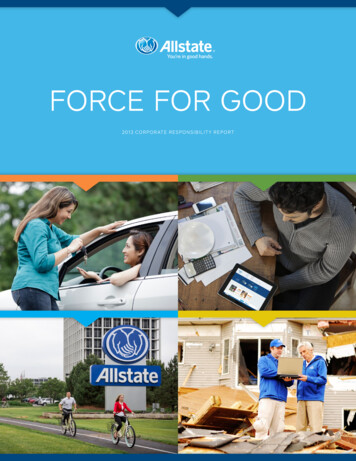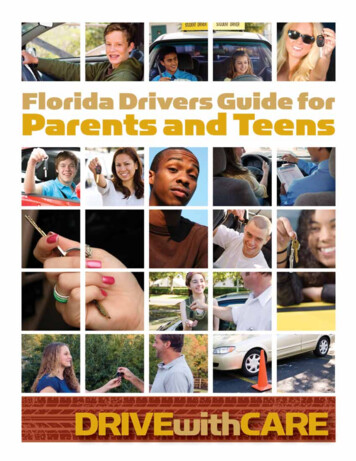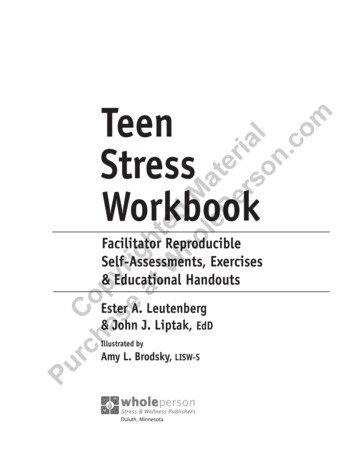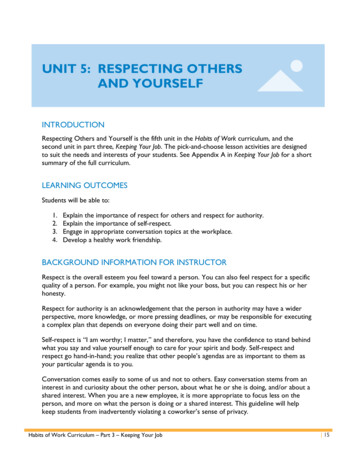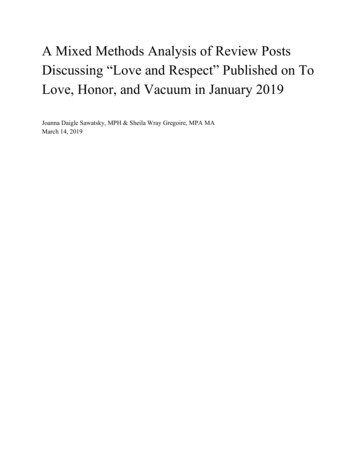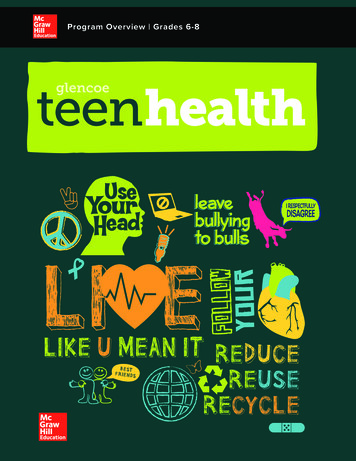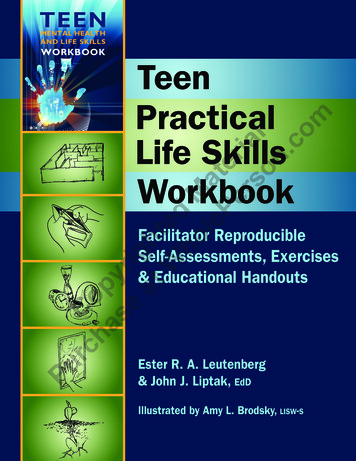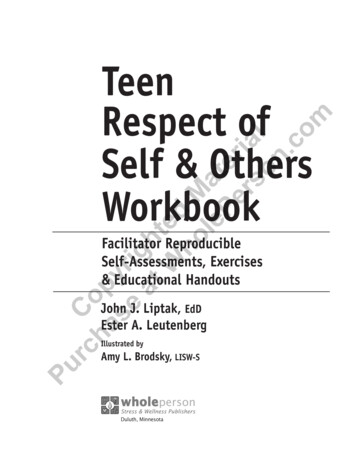
Transcription
rc Coha pse yriat ghW tedho Mle atPe errs ialon.comTeenRespect ofSelf & OthersWorkbookFacilitator ReproducibleSelf-Assessments, Exercises& Educational HandoutsJohn J. Liptak, EdDEster A. LeutenbergPuIllustrated byAmy L. Brodsky, LISW-SDuluth, Minnesota
rc Coha pse yriat ghW tedho Mle atPe errs ialon.comWhole Person210 West Michigan StreetDuluth, MN leperson.comTeen Respect of Self & Others WorkbookFacilitator Reproducible Self-Assessments,Exercises & Educational HandoutsCopyright 2011 by Ester A. Leutenberg and John J. Liptak.All rights reserved. Except for short excerpts for review purposesand materials in the assessment, journaling activities, andeducational handouts sections, no part of this book may bereproduced or transmitted in any form by any means, electronicor mechanical without permission in writing from the publisher.Self-assessments, exercises, and educational handouts are meantto be photocopied.All efforts have been made to ensure accuracy of the informationcontained in this book as of the date published. The author(s)and the publisher expressly disclaim responsibility for anyadverse effects arising from the use or application of theinformation contained herein.Printed in the United States of America10 9 8 7 6 5 4 3 2 1PuEditorial Director: Carlene SippolaArt Director: Joy Morgan DeyLibrary of Congress Control Number: 2011927795ISBN: 978-1-57025-251-8
Using This Book(For the professional)Respect comes in three forms — respect for self, respect for others and respect for communityand environment. Although these three forms of respect may not appear to be connected, they areinterconnected in several ways:rc Coha pse yriat ghW tedho Mle atPe errs ialon.com For people to show respect to other people, animals, nature, environment and the globalcommunity, they must have deep respect for themselves. Without respect for self, itbecomes difficult to empathize with the plight of others. People are constantly attempting to balance their self-interests and the interests of others. A basic human value that individuals strive for is social interest, or the concern andrespect for other people in the world and commitment to build a better future for others.Showing social interest and respect is so important that many view it as an indicator ofpositive mental health and overall wellness. People with little social interest and lack ofrespect for others tend to be more self-centered and intolerant of others. On the otherhand, people who are concerned about others and who want to help others are morelikely to have greater life satisfaction, more positive mental health and a greater senseof overall wellness. They are able to develop feelings of happiness and success becausethey feel pleasure in being respectful and therefore, they experience a sense of socialconnectedness.Following is a model that describes the “respecting self and others” cycle of wellness:RespectofSelfSocialActionPuKindness tothe GlobalCommunityRespectofOthersGenerosityBy being concerned about others, people experience a greater sense of generosity, contribute to thewell-being of others, and find joy in their sense of social interest. This social interest then propelspeople to be more respectful in the workplace, kinder to the universe, and more apt to be interested insocial justice. Whether service to the community (or world) is found through formal organizations orthrough informal involvement in social issues, people are able to find their own place in the world.(Continued on the next page)
Using This Book(For the professional, continued)The Teen Respect of Self and Others Workbook contains five separate sections to help participants learnmore about themselves, the skills they possess and those they need to learn to be of service to otherpeople and make contributions to the welfare of others. Participants will learn about the importance ofthese skills in the development of personal and professional success.rc Coha pse yriat ghW tedho Mle atPe errs ialon.comThe sections of this book are:1) SELF-RESPECT SCALE helps individuals identify their own level of self-respect by exploring theirself-confidence, self-efficacy, self-acceptance and self-love.2) RESPECT OF OTHERS SCALE helps individuals identify how respectful they are to other peoplethrough their courtesy, caring, tolerance, trust and respect levels.3) GENEROSITY SCALE helps individuals identify and explore their level of generosity with theirtime, talents and resources.4) KINDness TO THE GLOBAL COMMUNITY helps individuals explore how kind and respectfulthey are in trying to preserve the environment and by focusing on the universe, energy, nature andkind-to-self lifestyle. See Team Suggestion on page 85.5) SOCIAL ACTION SCALE helps individuals identify their altruistic-level and to identify ways to beof service to others in the community by concerning themselves with positive views of others,welfare of others, sense of community and social support.These sections serve as avenues for individual self-reflection, as well as for group experiences revolvingaround identified topics of importance. Each assessment includes directions for easy administration,scoring and interpretation. Each section includes exploratory activities, reflective journaling activities andeducational handouts to help participants discover their habitual effective and ineffective relationshipskills and provides instruction for enhancing their most critical partner-relationship weaknesses.PuThe art of self-reflection goes back many centuries and is rooted in many of the world’s greatest spiritualand philosophical traditions. Socrates, the ancient Greek philosopher, was known to walk the streetsengaging the people he met in philosophical reflection and dialogue. He felt that this type of activitywas so important in life that he went so far as to proclaim, “The unexamined life is not worth living!” Theunexamined life is one in which the same routine is continually repeated without ever thinking aboutits meaning to one’s life and how this life really could be lived. However, a structured reflection andexamination of beliefs, assumptions, characteristics, and patterns can provide a better understanding,which can lead to a more satisfying life. A greater level of self-understanding about important life skills isoften necessary to make positive, self-directed changes in the negative patterns that keep repeating. Theassessments and exercises in this book can help promote this self-understanding. Through involvementin the in-depth activities, the participant claims ownership in the development of positive patterns.Journaling is an extremely powerful tool for enhancing self-discovery, learning, transcending traditionalproblems, breaking ineffective life habits, and helping to heal from psychological traumas of the past.From a physical point of view, writing reduces stress and lowers muscle tension, blood pressure andheart rate levels. Psychologically, writing reduces sadness, depression and general anxiety, and leadsto a greater level of life satisfaction and optimism. Behaviorally, writing leads to enhanced social skills,emotional intelligence and creativity. It also leads to improved relationship skills which lead to moreself-confidence in intimate relationships.(Continued on the next page)
Using This Book(For the professional, continued)By combining reflective assessment and journaling, participants will be exposed to a powerful methodof combining verbalizing and writing to reflect on and solve problems. Participants will become moreaware of their outlook in life, the joys and satisfaction they are currently experiencing, and ways ofenhancing their life satisfaction.rc Coha pse yriat ghW tedho Mle atPe errs ialon.comPreparation for using the assessments and activities in this book is important. Theauthors suggest that prior to administering any of the assessments in this book, youcomplete them yourself. This will familiarize you with the format of the assessments, thescoring directions, the interpretation guides and the journaling activities, although theassessments are designed to be self-administered, scored and interpreted. This familiaritywill help prepare facilitators to answer questions about the assessments for participants.About the Assessments, Journaling Activitiesand Educational HandoutsThe Assessments, Journaling Activities, and Educational Handouts in the Teen Respect of Self andOthers Workbook are reproducible and ready to be photocopied for participants’ use. Assessmentscontained in this book focus on self-reported ideas, beliefs and experiences from the participants.Accuracy and usefulness of the information provided depends on the truthful information that eachparticipant provides through self-examination. By being honest, participants help themselves to learnabout unproductive and ineffective friendship patterns, and to uncover information that might bekeeping them from being as happy and / or as successful in relationships as they might be.Advise the teens using the assessments they should not spend too much time trying to analyze thecontent of the questions; their initial response will most likely be true. Regardless of individual scores,encourage participants to write and talk about their findings and their feelings pertaining to what theyhave discovered about themselves. Exploring teen respect exercises will be helpful to the teens nowand as they mature into adulthood.USE CODES FOR CONFIDENTIALITYPuConfidentiality is a term for any action that preserves the privacy of other people. Becausethe teens completing the activities in this workbook will be asked to answer assessmentitems and to journal about people in their lives, you will need to discuss confidentialitybefore you begin using the materials in this workbook. Maintaining confidentiality isimportant as it shows respect for others and allows the participants to explore theirfeelings without hurting anyone’s feelings or fearing gossip, harm or retribution.In order to maintain confidentiality, explain to the participants that they need to assigna code name for each person they write about as they complete the various activities inthe workbook. For example, a person they know might have a relative who has blond hairmight be titled HBH (Has Blonde Hair) for a particular exercise. In order to protect theiridentities, they may not use people’s actual names or initials – just codes.
Layout of the Bookrc Coha pse yriat ghW tedho Mle atPe errs ialon.comThis Book Includes:q Assessment Instruments – Self-assessment inventories with scoring directions andinterpretation materials. Group facilitators can choose one or more of the activitiesrelevant to their participants.q Activity Handouts – Practical questions and activities that prompt self-reflection andpromote self-understanding. These questions and activities foster introspection andpromote pro-social behaviors.q Quotations – Quotations are used in each section to provide insight and promoteself-reflection. Participants will be asked to select one or more of the quotations andjournal about what the quotations mean to them.q Reflective Questions for Journaling – Self-exploration activities and journalingexercises specific to each assessment to enhance self-discovery, learning, and healing.q Educational Handouts – Handouts designed to enhance instruction can be usedindividually or in groups.They can be distributed, converted into masters foroverheads or transparencies, projected or written down on a board and discussed.Who Should Use This Program?This book has been designed as a practical tool for helping professional therapists, counselors,marriage and family therapists, psychologists, teachers, group leaders, etc. Depending on the roleof the professional using the Teen Respecting Yourself and Others Workbook and the specific group’sneeds, these sections can be used individually, combined, or implemented as part of an integratedcurriculum for a more comprehensive approach.Why Use Self-Assessments?Self-assessments are important in teaching various life skills. Participants will . . . Become aware of the primary motivators that guide behavior.Explore and learn to indentify potentially harmful situations.Explore the effects of messages received in childhood.Gain insight that will guide behavioral change.Focus their thinking on behavioral goals for change.Uncover resources they possess that can help to cope with problems and difficulties.Explore their personal characteristics without judgment.Develop full awareness of personal strengths and weaknesses.PuBecause the assessments are presented in a straightforward and easy-to-useformat, individuals can self-administer, score and interpret each assessment attheir own pace.Thanks to the following whose input in this book has been so valuable!Amy L. Brodsky, LISW-SCarol Butler, MS Ed, RN, CKathy Liptak, Ed.D.Kathy A. Khalsa, MAJS, OTR / LEileen Regen, M.Ed., CJEJay LeutenbergLucy Ritzic, OTR / L
Introduction(For the participant)rc Coha pse yriat ghW tedho Mle atPe errs ialon.comYou often hear that you need to be kind to other people, animals and the universe. Before you cando that, you must be kind to yourself. You need to be yourself and recognize that you are human,find ways to be patient with yourself and forgive yourself. Remember that respect is a two-waystreet that begins with your ability to respect yourself and then transfer that respect to other people,environment, animals and the global community. To live effectively, you must blend personalmotivation and commitment with social commitment and the concern for the well-being and welfare ofother people, animals and nature.Your experiences can have a profound effect on the welfare of others. It can be very easy to respectyourself and work toward your own self-interest; however, respecting and helping others can be a littlemore challenging. Respecting others suggests it is possible to balance self-interest with respect andconcern for others. This workbook is designed to help you look at your level of respect for others andto provide activities to help you to further develop your concern and commitment to others.Interestingly, all of the research indicates that there are multiple effects when people show respect forothers — to the other people, the universe and you. People who help others and show respect andsocial interest have greater personal and life satisfaction, as well as greater well-being. When you showrespect, both you and others will benefit. Social interest has been shown to provide individuals withthese feelings: purpose and meaning in life an inner sense of benevolence satisfaction pride a sense of wellness and decreased stress a greater sense of responsibilityYou can use this workbook to help you develop the skills and attitudes needed to be more respectful.You will be encouraged throughout the workbook to complete assessments, journaling activities, andexercises. Because active involvement and doing is as important as theories, it is critical that you workhard and take the time to complete all of the skill-building exercises.PuIMPORTANT — You will be asked to respond to assessment items and journal aboutvarious people in your life. Everyone has the right to confidentiality, and you need tohonor the right to privacy of others. Think about it this way — you would not wantsomeone writing things about you that other people could read about. The people in yourlife feel this way also. Do not use people’s actual names when you are listing anyone.In order to maintain the confidentiality of people you know, assign them code names basedon things you know about them. For example, a friend who loves chocolate might have thecode of HLC (He Loves Chocolate).
Teen Respect of Self & Others Workbooktable of ContentsSection I: Self-Respect Scalerc Coha pse yriat ghW tedho Mle atPe errs ialon.comScale Directions . . . . . . . . . . . . . . . . . . . . . . . . . . . . . . . . . . . . 15Scale . . . . . . . . . . . . . . . . . . . . . . . . . . . . . . . . . . . . . . . . . 16–17Scoring Directions . . . . . . . . . . . . . . . . . . . . . . . . . . . . . . . . . . . 18Profile Interpretation . . . . . . . . . . . . . . . . . . . . . . . . . . . . . . . . 18ExercisesSelf-Confidence – Stop Comparing Yourself to Others . . . . . . . 19Self-Confidence – Identify the Cause ofYour Lack of Self-Confidence . . . . . . . . . . . . . . . . . . . . . . . 20Self-Confidence – Goal Setting . . . . . . . . . . . . . . . . . . . . . . . . . 21Self-Effectiveness – Actions to Achieving My Goals . . . . . . . . . 22Self-Effectiveness – My Competencies . . . . . . . . . . . . . . . . . . . 23Self-Acceptance – How Others Want Me to Be . . . . . . . . . . . . . 24Self-Acceptance – What I Like about Myself . . . . . . . . . . . . . . . 25Self-Love . . . . . . . . . . . . . . . . . . . . . . . . . . . . . . . . . . . . . . 26–28Self-Love – Accepting Yourself . . . . . . . . . . . . . . . . . . . . . . 29–30Journaling ActivitiesSelf-Respect Quotations . . . . . . . . . . . . . . . . . . . . . . . . . . . . . . 31Educational HandoutsWays to Respect Yourself . . . . . . . . . . . . . . . . . . . . . . . . . . . . . 32Obstacles to Self-Respect . . . . . . . . . . . . . . . . . . . . . . . . . . . . . 33Section II: Respect of Others ScaleScale Directions . . . . . . . . . . . . . . . . . . . . . . . . . . . . . . . . . . . . 37Scale . . . . . . . . . . . . . . . . . . . . . . . . . . . . . . . . . . . . . . . . . 38–39PuScoring Directions . . . . . . . . . . . . . . . . . . . . . . . . . . . . . . . . . . . 40Profile Interpretation . . . . . . . . . . . . . . . . . . . . . . . . . . . . . . . . 40ExercisesCourtesy . . . . . . . . . . . . . . . . . . . . . . . . . . . . . . . . . . . . . . 41–42Care . . . . . . . . . . . . . . . . . . . . . . . . . . . . . . . . . . . . . . . . . . 43–44Tolerant . . . . . . . . . . . . . . . . . . . . . . . . . . . . . . . . . . . . . . . . 45–46Trustworthy . . . . . . . . . . . . . . . . . . . . . . . . . . . . . . . . . . . . 47–48Respectful . . . . . . . . . . . . . . . . . . . . . . . . . . . . . . . . . . . . . 49–50
table of ContentsJournaling Activitiesrc Coha pse yriat ghW tedho Mle atPe errs ialon.comRespect Quotations . . . . . . . . . . . . . . . . . . . . . . . . . . . . . . . . . 51Respect - Respectful Examples . . . . . . . . . . . . . . . . . . . . . . . . . 52Disrespectful Examples . . . . . . . . . . . . . . . . . . . . . . . . . . . . 53–54Educational HandoutsHow to Build Respect . . . . . . . . . . . . . . . . . . . . . . . . . . . . . . . . 55Section III: Generosity ScaleScale Directions . . . . . . . . . . . . . . . . . . . . . . . . . . . . . . . . . . . 59Scale . . . . . . . . . . . . . . . . . . . . . . . . . . . . . . . . . . . . . . . . . . . . 60Scoring Directions . . . . . . . . . . . . . . . . . . . . . . . . . . . . . . . . . . . 61Profile Interpretation . . . . . . . . . . . . . . . . . . . . . . . . . . . . . . . . 61ExercisesGenerosity in the Past . . . . . . . . . . . . . . . . . . . . . . . . . . . . . . . 62Cultivating Generosity . . . . . . . . . . . . . . . . . . . . . . . . . . . . . . . 63Daily Generosity . . . . . . . . . . . . . . . . . . . . . . . . . . . . . . . . . . . . 64Generosity Motivation . . . . . . . . . . . . . . . . . . . . . . . . . . . . . . . 65Start Small . . . . . . . . . . . . . . . . . . . . . . . . . . . . . . . . . . . . . . . . 66Helping Others . . . . . . . . . . . . . . . . . . . . . . . . . . . . . . . . . . . . . 67Becoming Dedicated . . . . . . . . . . . . . . . . . . . . . . . . . . . . . . . . 68From Pain Comes Compassion . . . . . . . . . . . . . . . . . . . . . . . . 69Being Kind . . . . . . . . . . . . . . . . . . . . . . . . . . . . . . . . . . . . . 70–71Kindness . . . . . . . . . . . . . . . . . . . . . . . . . . . . . . . . . . . . . . . . . 72Journaling ActivitiesA Generosity Quotation . . . . . . . . . . . . . . . . . . . . . . . . . . . . . . 73PuHelping . . . . . . . . . . . . . . . . . . . . . . . . . . . . . . . . . . . . . . . . 74–76Educational HandoutsFacts about Generosity . . . . . . . . . . . . . . . . . . . . . . . . . . . . . . . 77Section IV: Kindness to the Global Community ScaleScale Directions . . . . . . . . . . . . . . . . . . . . . . . . . . . . . . . . . . . . 81Scale . . . . . . . . . . . . . . . . . . . . . . . . . . . . . . . . . . . . . . . . . 82–83Scoring Directions . . . . . . . . . . . . . . . . . . . . . . . . . . . . . . . . . . . 84
table of ContentsProfile Interpretation . . . . . . . . . . . . . . . . . . . . . . . . . . . . . . . . 85rc Coha pse yriat ghW tedho Mle atPe errs ialon.comTeam Suggestion to the Facilitator . . . . . . . . . . . . . . . . . . . . . . 85ExercisesScale Description – Community – My Social Network . . . . . . . 86My Past Social Network . . . . . . . . . . . . . . . . . . . . . . . . . . . . . . . 87My Network . . . . . . . . . . . . . . . . . . . . . . . . . . . . . . . . . . . . . . . 88Scale Description – Energy . . . . . . . . . . . . . . . . . . . . . . . . . . . . 89Conserving Energy . . . . . . . . . . . . . . . . . . . . . . . . . . . . . . . . . . 90Scale Description – Nature . . . . . . . . . . . . . . . . . . . . . . . . . . . . 91Preserving Nature . . . . . . . . . . . . . . . . . . . . . . . . . . . . . . . . . . . 92Scale Description – Kindness to Self Lifestyle . . . . . . . . . . . . . . 93Defining Success . . . . . . . . . . . . . . . . . . . . . . . . . . . . . . . . . . . 94Redefining Success . . . . . . . . . . . . . . . . . . . . . . . . . . . . . . . . . 95Journaling ActivitiesKindness to the Global Community Quotations . . . . . . . . . . . . 96Preserving the Global Community . . . . . . . . . . . . . . . . . . . . . . 97Educational HandoutsBe Kind to the Global Community . . . . . . . . . . . . . . . . . . . . . . . 98Kind People . . . . . . . . . . . . . . . . . . . . . . . . . . . . . . . . . . . . . 99Section V: Social Action ScaleScale Directions . . . . . . . . . . . . . . . . . . . . . . . . . . . . . . . . . . . 103Scale . . . . . . . . . . . . . . . . . . . . . . . . . . . . . . . . . . . . . . . 104–105Scoring Directions . . . . . . . . . . . . . . . . . . . . . . . . . . . . . . . . . . 106Profile Interpretation . . . . . . . . . . . . . . . . . . . . . . . . . . . . . . . 106Descriptions . . . . . . . . . . . . . . . . . . . . . . . . . . . . . . . . . . . . . . 107PuExercisesReflecting on Your Social Altruism – Motives . . . . . . . . . . . . . 108Interests . . . . . . . . . . . . . . . . . . . . . . . . . . . . . . . . . . . . . . . . . 109My Volunteering – Small Projects . . . . . . . . . . . . . . . . . . . . . . 110My Volunteering – Large Projects . . . . . . . . . . . . . . . . . . . . . . 111Where or How I Can Help . . . . . . . . . . . . . . . . . . . . . . . . 112–115Benefits of Volunteering . . . . . . . . . . . . . . . . . . . . . . . . . . . . . 116Why Not? . . . . . . . . . . . . . . . . . . . . . . . . . . . . . . . . . . . . . . . . 117
table of ContentsJournaling Activitiesrc Coha pse yriat ghW tedho Mle atPe errs ialon.comDo Good Anyway . . . . . . . . . . . . . . . . . . . . . . . . . . . . . . . . . . 118Being a Volunteer and / or Social Activist . . . . . . . . . . . . . . . . 119Educational HandoutsExcuses People Use to Avoid Helping Others . . . . . . . . . . . . . 120PuTips for Your Volunteer Experiences . . . . . . . . . . . . . . . . . . . 121
Section I: Activity HandoutsIdentify the Cause of Your Lack of Self-ConfidenceIt is important to identify where and why you feel a lack of self-confidence. In the tablebelow, identify some of the reasons you feel vulnerable or not as good as other people.Reasons I Feel Self-ConfidentReasons I Lack Self-Confidencerc Coha pse yriat ghW tedho Mle atPe errs ialon.comMy PhysicalAppearanceMy Cultural,Religious, Spiritual,Ethic, Sexualand / or GenderDifferencesMy Brain PowerMy SchoolSuccessMy PastMy FamilyMy FriendsPuMy TalentsOther20 2011 Whole Person Associates, 210 West Michigan St., Duluth MN 55802-1908 800-247-6789
The sections of this book are: 1) SELF-RESPECT SCALE. helps individuals identify their own level of self-respect by exploring their . self-confidence, self-efficacy, self-acceptance and self-love. 2) RESPECT OF OTHERS SCALE. helps individuals identify how respectful they are to other people
